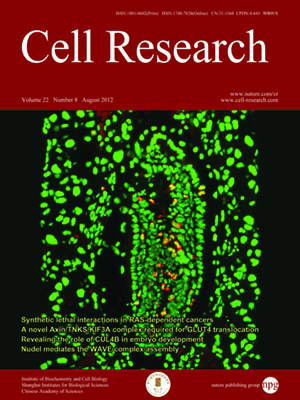
Volume 22, No 8, Aug 2012
ISSN: 1001-0602
EISSN: 1748-7838 2018
impact factor 17.848*
(Clarivate Analytics, 2019)
Volume 22 Issue 8, August 2012: 1270-1284
ORIGINAL ARTICLES
Nudel is crucial for the WAVE complex assembly in vivo by selectively promoting subcomplex stability and formation through direct interactions
Shuang Wu1, Li Ma1, Yibo Wu2, Rong Zeng2 and Xueliang Zhu1
1State Key Laboratory of Cell Biology, Institute of Biochemistry and Cell Biology, Shanghai Institutes for Biological Sciences, Chinese Academy of Sciences, 320 Yue Yang Road, Shanghai 200031, China
2State Key Laboratory of Molecular Biology, Institute of Biochemistry and Cell Biology, Shanghai Institutes for Biological Sciences, Chinese Academy of Sciences, 320 Yue Yang Road, Shanghai 200031, China
Correspondence: Xueliang Zhu,(xlzhu@sibs.ac.cn)
The WAVE regulatory complex (WRC), consisting of WAVE, Sra, Nap, Abi, and HSPC300, activates the Arp2/3 complex to control branched actin polymerization in response to Rac activation. How the WRC is assembled in vivo is not clear. Here we show that Nudel, a protein critical for lamellipodia formation, dramatically stabilized the Sra1-Nap1-Abi1 complex against degradation in cells through a dynamic binding to Sra1, whereas its physical interaction with HSPC300 protected free HSPC300 from the proteasome-mediated degradation and stimulated the HSPC300-WAVE2 complex formation. By contrast, Nudel showed little or no interactions with the Sra1-Nap1-Abi1-WAVE2 and the Sra1-Nap1-Abi1-HSPC300 complexes as well as the mature WRC. Depletion of Nudel by RNAi led to general subunit degradation and markedly attenuated the levels of mature WRC. It also abolished the WRC-dependent actin polymerization in vitro and the Rac1-induced lamellipodial actin network formation during cell spreading. Therefore, Nudel is important for the early steps of the WRC assembly in vivo by antagonizing the instability of certain WRC subunits and subcomplexes.
Cell Research (2012) 22:1270-1284. doi:10.1038/cr.2012.47; published online 27 March 2012
FULL TEXT | PDF
Browse 2081


